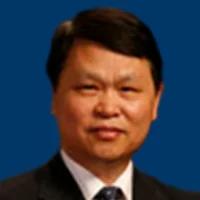- Center on Health Equity & Access
- Clinical
- Health Care Cost
- Health Care Delivery
- Insurance
- Policy
- Technology
- Value-Based Care
ADC Improvements Mean More Targets, New Questions About Sequencing
Coverage of a session on antibody drug conjugates from the 2024 American Society of Clinical Oncology Annual Meeting.
Updates about antibody-drug conjugates (ADCs) were coming so fast at the 2024 American Society of Clinical Oncology (ASCO) Annual Meeting that Sarah Cannon Research Institute’s Erika P. Hamilton, MD, included a “breaking news” slide in her opening presentation at the June 2 session, “Next-Generation Antibody-Drug Conjugates: the Revolution Continues.”1
The results, presented the day prior, evaluated enfortumab vedotin (Padcev, Astellas/Seagen), a Nectin-4-directed ADC, in metastatic hormone receptor-positive (HR+)/HER2- and triple negative breast cancer (TNBC) (NCT04225117).2
Erika P. Hamilton, MD | Image credit: Sarah Cannon Research Institute

But then Hamilton, the director of Breast Cancer and Gynecologic Cancer Research at Sarah Cannon Research Institute, had one more tweak: she added results for the phase 3 DESTINY-Breast06 trial (NCT04494425), which were just 2 hours old. They involved trastuzumab deruxtecan (Enhertu, AstraZeneca), which showed statistically significant improvements in progression-free survival (PFS) compared with chemotherapy in patients with HR+/HER2-low and HER2-ultralow breast cancer.3
Together, the trials highlighted key points from Hamilton’s remarks: the enfortumab vedotin data showed similar PFS regardless of prior treatment with sacituzumab govitecan (Trodelvy, Gilead), which has important implications for sequencing therapeutic options. And the DESTINY-Breast06 results show that in the generation since the first ADCs arrived in 2000, improvements in “linker” technology mean these drugs can be given to a broader spectrum of patients.
“ADCs are really revolutionizing cancer therapeutics across both solid and liquid tumors,” Hamilton said. “They provide an advantage over traditional cytotoxic chemotherapy in terms of side effects. They’ve evolved from targeting only high antigen expression now, in fact, to most not needing to test expression.”
However, she said, "We still have a lot of questions around resistance and sequencing."
Hamilton explained that a key variable in these therapies is the drug to antibody ratio, or DAR. Newer ADCs, such as sacituzumab govitecan and trastuzumab deruxtecan, have a cleavable linker and a higher DAR. “You really see an explosion of these approved agents around 2019, with 6 approved in solid tumors and 6 approved in hematologic malignancies,” she said.
Although the basic elements of ADCs are the same across therapies, there are differences in payload and adverse events (AEs), and some still require target expression for activity. As a group, ADCs offer a powerful attack on their target with more limited AEs than traditional chemotherapy.
“Toxicities are not a class effect,” she said. “ADCs certainly minimize systemic toxicity compared with chemotherapy, yet they’re all associated with unique side effects.”
She noted the ocular effects of some drugs, such as mirvetuximab soravtansine (Elahere, ImmnoGen), which is approved to treat platinum-resistant ovarian cancer.4 Nausea is seen in trastuzumab deruxtecan, “and then we have quite a few that have hematologic toxicity.”
Use of ADCs in community settings, she said, will “require recognition of the unique side effects of each agent, so we can help with supportive care medications and prophylactic medications for our patients, so they can best tolerate these drugs.”
Hamilton led the audience through a discussion of mechanisms of resistance, noting that clinicians will face target options and choices. There is the prospect of bispecific ADCs with dual targets becoming available. “We are still in the infancy of understanding resistance and how best to sequence. Understanding when and if expression matters is integral, and novel targets and payloads will probably be key to allow meaningful sequencing.”
Patient Perspective. Sabrina Mayhew, PhD, RN, CN-BN, of the Quantum Leap Healthcare Collaborative, shared her thoughts on the “excitement and anticipation” that ADCs have generated, both among patients and the public. But she cautioned that the descriptions of the “acceptable” or “manageable” safety profile in abstracts can still translate into substantial impacts on quality of life. “While the symptoms may not be life-threatening, they can still impair daily functioning and diminish overall well-being,” she said.
Sabrina Mayhew, PhD, RN, CN-BN | Image credit: Wayne State University

Financial burdens can be large, too. “Patients face large out-of-pocket costs, including premiums for insurance coverage. The financial strain often forces patients to make difficult decisions between prioritizing their health care needs or meeting other essential expenses such as rent or groceries.” Regulatory agencies often do not ask about this, Mayhew said, and researchers should.
Finally, access is an issue. “Some ADCs are only available through a clinical trial,” and patients must meet specific criteria. Involving the advocate’s perspective earlier in the process would help researchers ensure “that their work remains patient centered.”
“Ultimately, the goal of treatment is to prolong survival while optimizing the quality of life, allowing patients to not only survive, but thrive and enjoy meaningful experiences during their lifetime,” Mayhew said. “Getting treatments faster is only useful if they really help people and do not cause harm.”
Solid Tumor Trials: LUMINOSITY and OptiTROP-Breast01
David Ross Camidge, MD, PhD, professor of medicine, University of Colorado Cancer Center then presented the primary analysis for the phase 2 LUMINOSITY trial (NCT03539536), “Telisotuzumab vedotin monotherapy for patients with previously treatment c-MET overexpressing non-squamous EGFR wild-type advanced non-small cell lung cancer (NSCLC).”5
David Ross Camidge, MD, PhD | Image credit: IASLC

Known as Teliso-V, this ADC is a first in class therapy directed against surface c-MET expression, seen in about 25% of EGFR wildtype NSCLC. Patients had locally advanced or metastatic c-MET overexpressed disease and at least 2 prior lines of therapy, including chemotherapy, immunotherapy (I/O), or sequential chemotherapy and I/O. Primary end point was overall response rate (ORR). Results showed the following:
- 172 patients received at least 1 dose of Teliso-V and made up the safety population.
- 161 (78 c-MET high, 83 c-MET intermediate) were in the baseline and efficacy analyses.
- Median age, 64 years; 69% male; 70% ECOG PS 1.
- 97.5% prior platinum chemotherapy; 82.0% prior immune checkpoint inhibitor.
- ORR was 34.6%, c-MET high; 22.9%, c-MET intermediate; 28.6% overall.
- Median duration of response (DOR): 9.0 months, c-MET high; 7.2 months, c-MET intermediate; 8.3 months, overall.
- Treatment-related AEs: peripheral neuropathy, 30%; peripheral edema, 16%, fatigue, 14%. Two patients died from interstitial lung disease (ILD) and respiratory failure.
Camidge noted that 9% of the patients stopped therapy due to ILD, with the median time to stopping therapy being 48 days. “In contrast, 10% discontinued for peripheral neuropathy, with the median time, to discontinuation being 222.5 days, suggesting this reflects a cumulative exposure,” he said.
With the higher MET protein levels associated with higher response rates, “additional analyses of protein expression overlapping with MET genetic abnormalities—for example, mutations or amplifications—are ongoing.”
Next, Binghe Xu, MD, PhD, of Cancer Hospital, Chinese Academy of the Medical Sciences, presented results from OptiTROP-Breast01, evaluating sacituzumab tirumectecan (sac-TMT) in patients with previously treated locally recurrent or metastatic TNBC (NCT05347134).6 Merck has licensed the ADC from Sichuan Kelun-Biotech.
According to the abstract, the therapy has a novel linker to conjugate with the payload, a belotecan-derivative topoisomerase I inhibitor with a DAR of 7.4, and the linker design enables the bystander effect. The phase 3 study compared sac-TMT (n = 130) with physician’s choice of chemotherapy (n = 133). Per the abstract, results were as follows:
- Median age was 51 years; 87% had visceral metastases
- 26% had prior PD-1/PD-L1 inhibitors; 48% had at least 3 prior lines of chemotherapy
- Primary PFS end point was met with 69% reduction in risk of disease progression or death (HR 0.31; 95% CI, 0.22-0.45; P < .00001)
- Median PFS (assessed by blinded central review) was 5.7 months (95% CI, 4.3-7.2) for sac-TMT vs 2.3 months (95% CI, 1.6 to 2.7 ) for chemotherapy. PFS at 6 months was 43.4% vs 11.1%.
- At the first planned interim analysis for overall survival (OS) (data cutoff: Nov 30, 2023) with median follow-up of 10.4 months, OS was statistically significant favoring sac-TMT (HR 0.53; 95% CI, 0.36-0.78; P =0.0005); median OS for sac-TMT was not reached (95% CI, 11.2 to NE) and was 9.4 months (95% CI, 8.5 to 11.7) with chemotherapy.
- The objective response rate assessed blinded central review was 43.8% with sac-TMT and 12.8% with chemotherapy.
- Common grade or higher TRAEs for sac-TMT vs chemotherapy were neutrophil count decreased (32.3% vs 47.0%), anemia (27.7% vs 6.1%) and white blood cell count decreased (25.4% vs 36.4%).
Binghe Xu, MD, PhD | Image credit: OncLive

Xu said results were strong across subgroups, favoring sac-TMT over chemotherapy for those with 3 prior lines of therapy, for those pretreated with PD-1/PD-L1 inhibitors, and for HER2 expression. In patients with high TROP2 expression, he said, “median PFS was 8.3 months in sac-TMT and 2.3 months [for] chemotherapy.”
In addition, “Sac-TMT had a better [overall response] and duration of response than chemotherapy, regardless of TROP2 expression.”
Besides the TRAEs reported in the abstract, Xu said sac-TMI caused lower incidence of elevated liver enzymes than chemotherapy; in the sac-TMT group, 2 patients reported peripheral neuropathy. A phase 3 clinical trial for frontline TNBC and adjuvant treatment in early-stage TNBC are ongoing, he said.
Commentary. Giampaolo Bianchini, MD, of Universita Vita-Salute, San Raffaele, Milan, Italy, offered comments on the 2 solid tumor studies. He noted that the different results for patents based on c-MET expression demonstrate the need for pinpoint patient selection in treatment. “Remember, these are all arbitrary cutoffs; arbitrary decisions to make,” Bianchini said. “Further effort to improve patient selection is obviously warranted.”
For the TNBC trial with sac-TMT, he said the design is very similar to the ASCENT trial with sacituzumab govitecan. (NCT02574455).7 A question here—referencing back to Hamilton’s discussion about sequencing—is which target to choose?
“Should we use HER2-low, and TROP2 eventually?” he asked. “Because you cannot treat a patient with 2 drugs. That’s a question that maybe we need to study. But this is also an example of how target assessment may become relevant in a competitive treatment landscape.”
ADC in Hematological Malignancy: DREAMM-8 in Multiple Myeloma
Suzanne Trudel, MD, MSc, of Princess Margaret Cancer Center, in Toronto, Canada, presented results for the late-breaking abstract, “Results from randomized phase 3 DREAMM-8 study (NCT04484623) of belantamab mafodotin (Blenrep, GlaxoSmithKline) plus pomalidomide (Pomalyst, Bristol Myers Squibb) and dexamethasone (BPd) vs pomalidomide plus bortezomib and dexamethasone (PVd) in relapsed/refractory multiple myeloma.”8
Suzanne Trudel, MD, MSc | Image credit: ASCO

Belantamab mafodotin binds to the protein BCMA, found on the surface of myeloma cells, then delivers chemotherapy to the targeted cell. The DREAMM-7 trial (NCT04246047) showed that in patients with relapsed or refractory multiple myeloma, the combination of belantamab mafodotin, bortezomib, and dexamethasone slowed the progression of multiple myeloma when compared to daratumumab (Darzalex) plus bortezomib and dexamethasone.9 DREAMM-8 examined a different comparison and randomized 302 patients to receive either BPd (n = 155) or PVd (n = 147), after they had received at least 1 treatment, including lenalidomide.8
Treatment continued until disease progression, death, unacceptable toxicity, end of the study or withdrawal of content, Trudel said. Patients were stratified by prior lines of therapy, especially prior exposure to bortezomib or an anti-CD38 antibody. The primary end point was PFS, and key secondary end points included OS, minimal residual disease negativity, DOR.
Results were as follows:
- Among the participants, 60% were men, 86% were White, and the average age was around 67 years. They followed for a median of nearly 22 months. Trudel said just over 50% of patients had more than 1 prior line of therapy.
- Median PFS was not reached for the participants who received BPd. For those who received PVd, the median PFS was 12.7 months.
- At 12 months, PFS was 71% for those receiving BPd compared to 51% of those receiving PVd. “This represents a clinically meaningful and statistically significant improvement in the reduction of death or progressive disease by 48%,” Trudel said.
- Overall response rate was 77% for those receiving BPd vs 72% for PVd. Also, 40% of patients receiving BPd achieved a complete response (CR) or better compared to 16% of patients receiving PVd.
- Among responders, median DOR was not yet reached in those receiving BPd, and it was 17.5 months in those who received PVd.
- More than 99% of those receiving BPd experienced AEs, as did 96% of those receiving PVd. Ocular-related side effects were common, affecting 89% of those in the BPd group and 30% of those in the PVd group. “However, while ocular events were frequent, they were generally reversible,” Trudel said.
Belantamab mafodotin has had an up-and-down approval history. The ADC received accelerated FDA approval based on results from DREAMM-2 but was withdrawn from the US market when the confirmatory DREAMM-3 trial did not meet targets. Officials from GSK told STAT News during ASCO they planned to seek new approvals from regulators.10
“This regimen could become an important treatment option for patients with multiple myeloma at first relapse and for subsequent relapses,” Trudel said. “It is suitable for a broad range of patients and can be given in a community oncology setting without the need for specialized cancer center support.”
Commentary. Sagar Lonial, MD, FACP, of Winship Cancer Institute and Emory University School of Medicine, said the very early separation of the DREAMM-8 arms is noteworthy. “This may have even longer progression-free survival than we saw in the DREAMM-7 study,” he said, “likely because of immune-mediated inflammatory disease interaction with an antibody drug conjugate that may enhance immune effects.”
Lonial said the AEs may require new thinking on dosing. “You can see here, 59% of patients had dose reductions on study. And dose delays occurred in 83% of patients…although the overall discontinuation rate was relatively low at 9%.”
The question, he said, is, “How do we most effectively deliver?” BCMA is a “great target” that can be modulated with a gamma secretase inhibitor, but the “collateral damage” of the payload must be considered. Dosing schedules should be balanced to address AE concerns with ADCs, “Do we always need to give more?” Lonial asked. “That is not necessarily the case when we’re talking about the antibody drug conjugates.”
“Patients and physicians worry that missed doses may impact progression-free survival. We now have evidence that suggests this is not true.”
Because of the unique target and payload in belantamab mafodotin, he said. “Missed doses may actually result in better safety profiles and maintain the efficacy of the treatment.”
References
- Hamilton EP. Next-generation antibody-drug conjugates: the revolution continues. Presented at: 2024 American Society of Clinical Oncology Annual Meeting, Chicago, IL; May 31-June 5, 2024.
- Giordano A, Awan AAA, Bruce JY, et al. Enfortumab vedotin (EV) in triple-negative breast cancer (TNBC) and HR+/HER2- breast cancer (BC) cohorts of EV-202. J Clin Oncol 2024;42(suppl 16); abstr 1005. doi: 10.1200/JCO.2024.42.16_suppl.1005
- Curigliano G, Hu X, Dent RA, et al. Trastuzumab dertuxecan (T-DXd) vs physician’s choice of chemotherapy (TPC) in patients (pts) with hormone receptor (HR+) human epidermal growth factor receptor 2 (HER2)-low or HER2-ultralow metastatic breast cancer (mBC) with prior endocrine therapy (ET): Primary results from DESTINY-Breast06. J Clin Oncol 2024;42(suppl 16); abstr LBA1000.
- FDA approves mirvetuximab soravtansine-gynx for FRα positive, platinum-resistant epithelial ovarian, fallopian tube, or primary peritoneal cancer. FDA Newsroom. Updated March 22, 2024. Accessed June 9, 2024. https://www.fda.gov/drugs/resources-information-approved-drugs/fda-approves-mirvetuximab-soravtansine-gynx-fra-positive-platinum-resistant-epithelial-ovarian
- Camidge DR, Bar J, Horinouchi H, et al. Telisotuzumab vedotin monotherapy in patients with previously treated c-Met–overexpressing non-squamous EGFR wildtype advanced NSCLC: Primary analysis of the LUMINOSITY trial. J Clin Oncol 2024;42(suppl 16):abstr 103. doi:10.1200/JCO.2024.42.16_suppl.103
- Xu B, Yin Y, Fan Y, et al. Sacituzumab tirumotecan (SKB264/MK-2870) in patients with previously treated locally recurrent or metastatic triple-negative breast cancer (TNBC): results from the OptiTROP-Breast01 study. J Clin Oncol 2024;42(suppl 16):abstr 104. doi:10.1200/JCO.2024.42.16_suppl.104
- Sardia A, Hurvitz SA, Tolaney AM, et al. Sacituzumab govitecan in metastatic triple-negative breast cancer. N Engl J Med.2021;384(16):1529-1541. doi:10.1056/NEJMoa2028485
- Trudel S, Beksac M, Pour L et al. Results from randomized phase 3 DREAMM-8 study of belantamab mafodotin plus pomalidomide and dexamethasone (BPd) vs pomalidomide plus bortezomib and dexamethasone (PVd) in relapsed/refractory multiple myeloma (RRMM). J Clin Oncol 2024;42(suppl 16):abstr LBA105. doi:10.1200/JCO.2024.42.16_suppl.LBA104
- Hungria V, Robak P, Hus M, et al. Belantamab Mafodotin, bortezomib and dexamethasone for multiple myeloma. N Engl J Med. Published June 1, 2024. doi:10.1056/NEJMoa2405090
- Joseph A. ASCO 2024: Data put a new shine on GSK blood cancer drug that was pulled from market. Stat News. June 2, 2024. Accessed June 8, 2024. https://www.statnews.com/2024/06/02/multiple-myeloma-blenrep-gsk-asco/
The Importance of Examining and Preventing Atrial Fibrillation
August 29th 2023At this year’s American Society for Preventive Cardiology Congress on CVD Prevention, Emelia J. Benjamin, MD, ScM, delivered the Honorary Fellow Award Lecture, “The Imperative to Focus on the Prevention of Atrial Fibrillation,” as the recipient of this year’s Honorary Fellow of the American Society for Preventive Cardiology award.
Listen
Tech Offers Empathy but Digital Divide Looms in Respiratory Health Care
November 25th 2025While artificial intelligence showed empathy and precision in respiratory health care, its equitable adoption is paramount to prevent the widening digital divide, as highlighted at the European Respiratory Society Congress 2025.
Read More
Oncology Onward: A Conversation With Dr Debra Patt of Texas Oncology
August 1st 2023Debra Patt, MD, PhD, MBA, joins hosts Emeline Aviki, MD, MBA, and Stephen Schleicher, MD, MBA, for episode 2 of our newest podcast, "Oncology Onward: Conversations With Innovators and Changemakers in Cancer Care."
Listen
